 Both of our Saturday Hollywood Fringe Festival (FB) dealt with pain, coming at it from two different angles. But that doesn’t mean the shows were pains: once was excellent, the other was pretty good. But first, however, my stock description of what the Fringe Festival is:
Both of our Saturday Hollywood Fringe Festival (FB) dealt with pain, coming at it from two different angles. But that doesn’t mean the shows were pains: once was excellent, the other was pretty good. But first, however, my stock description of what the Fringe Festival is:
* For those unfamiliar with Hollywood Fringe Festival (FB), there are over 390 different shows occurring in the heart of Hollywood, with most along the stretch of Santa Monica Blvd from Western to W of LaBrea, and between Hollywood Blvd and Melrose. The shows run from 5 minutes to 2 hours, from one person shows to gigantic casts, from mimes to musicals. They have one — and only one — thing in common: they have to be able to load into a theatre in 15 minutes or less, and get out afterwards in the same time. You never know what you will see: it could be complete crap, it could be the start of a major new show. The shows and scheduling thereof are a nightmare to coordinate, but you could easily end up seeing four to five shows in a day. However, you can be guaranteed of a good time.
And now, on to our Saturday shows…. and note that, after the shows, there’s a little bit more. Suffice it to say it is a tribute to 140, or perhaps a bit more, characters.
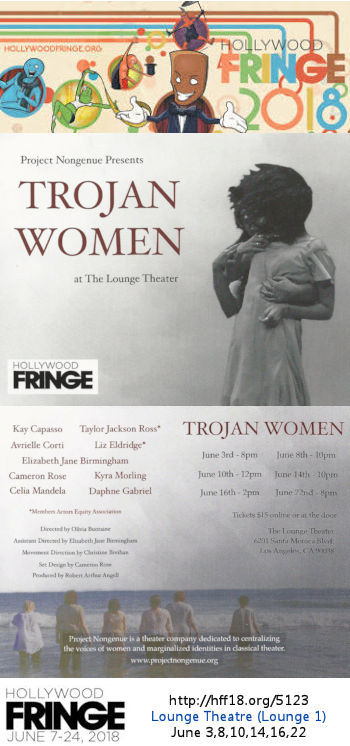 Our first show, Trojan Women, was billed as follows in the Hollywood Fringe online catalog:
Our first show, Trojan Women, was billed as follows in the Hollywood Fringe online catalog:
In perhaps one of the first recorded pieces of theater in the Western canon that passes the Bechdel test, Euripides’ Trojan Women tells a story of women who are stronger than gods. Trojan Women offers an unapologetic and powerful look at the act of community-building during times of grief, the gendered violence of war, and the messy aftermath of both real and mythic Greek conquests. Written circa 415 BCE and set immediately after the Trojan War, Trojan Women follows in real time the lives of nine remaining Trojan women (and two Greek men) as their city is captured.
For those unfamiliar, the “Bechdel Test” refers to a test was popularized by Alison Bechdel’s comic Dykes to Watch Out For, in a 1985 strip called The Rule. It is used to evaluate how women are protrayed in fiction. It consists of three simple requirements: (1) It has to have at least two [named] women in it; (2) Who talk to each other; (3) About something besides a man. I’d say this is mostly true, although there are a fair references to men — both as part of the conquering force, the Greeks, and references to children lost. But first, I should perhaps describe the story to you. That, in turn, requires some background for those unfamiliar with ancient Greek myths. Here’s how the program described it, edited a little:
Well before the story in the play started, the Gods had a party on Mt. Olympus. They chose to not invite Eris, the Goddess of Discord, perhaps because they felt she would ruin the vibe. Angered by this slight, Eris devised a way to ensure that she ruined their night. She threw a golden apple (known always after as The Apple of Discord) on which she had inscribed “to the fairest” into the party. Naturally, Hera (Goddess of Women), Aphrodite (Goddess of Love) and Athena (Goddess of Wisdom and War) each assumed the apple was for them. A fight ensued, and the three goddesses demanded that Zeus determine which of them was the fairest and deserved the apple. Knowing better than to get in the middle of this argument, Zeus suggested that Paris of Troy, a mortal he knew to have good judgement, should make the call. Each Goddess promised something different to Paris if he chose her: Hera promised immense power, Athena promised incredible strength, and Aphrodite promised the love of the most beautiful woman in the world. Paris chose Aphrodite, and thus, the love of Helen was promised to him.
The events that followed, and why they occurred, are still up to interpretation. We know Paris visited Greece while Greece and Troy were on good terms, and we know that Helen left her husband, Menelaus, and got on Paris’ boat headed back to Troy. Upon hearing that Helen was gone, Menelaus approached his brother Agamemnon, and they decided to wage war on Troy. This war lasted for ten years, and ended with Odysseus’ Trojan Horse. Greek soldiers hid inside a giant steel steed, which they had presented as a “Congrats on winning the war” present. In the middle of the night, while the Trojans celebrated what they thought was a victory, the Greek soldiers crept out of the horse, unlocked the gates of Troy for the rest of the soldiers who were waiting, and sacked the city. During that night, Paris died. Priam, King of Troy, died. Hector, Troy’s most steady and masterful warrior, had died days earlier. Almost all of the city is killed or enslaved. Left behind are only the Trojan Women. And Helen.
This play, which was the third part of a trilogy about the Trojan War by the Greek playwright Euripides, opens on a war camp in Troy after the Trojans have already lost to the Greeks. What follows is detailed well in the Wikipedia synopsis; you may find the story harder to follow on stage (I did) due to unfamiliarity with the backstory and the style of language used. Here’s the essence: The play follows the fates of the women of Troy after their city has been sacked, their husbands killed, and as they and their remaining families are about to be taken away as slaves. The focus is on how much the Trojan women have suffered as their grief is compounded when the Greeks dole out additional deaths and divide their shares of women. Through out play, a Greek herald, Talthybius, arrives to tell the women their fates. This includes the fact that the dethroned queen Hecuba will be taken away with the Greek general Odysseus, and Cassandra is destined to become the conquering general Agamemnon’s concubine. Cassandra, who can see the future, is morbidly delighted by this news: she sees that when they arrive in Argos, her new master’s embittered wife Clytemnestra will kill both her and her new master. However, Cassandra is also cursed so that her visions of the future are never believed, and she is carried off. From the widowed princess Andromache, wife of Hecuba’s late son Hector, Hecuba learns from her that her youngest daughter, Polyxena, has been killed as a sacrifice at the tomb of the Greek warrior Achilles. Andromache’s lot is to be the concubine of Achilles’ son Neoptolemus, and Andromache’s her baby son, Astyanax, has been condemned to die. Helen, who started this mess although not one of the Trojan women, is supposed to suffer greatly as well: Menelaus arrives to take her back to Greece with him where a death sentence awaits her. Helen begs and tries to seduce her husband into sparing her life. Menelaus remains resolved to kill her. Near the end of the play, Talthybius returns, carrying with him the body of little Astyanax on Hector’s shield. Andromache’s wish had been to bury her child herself, performing the proper rituals according to Trojan ways, but her ship had already departed. Talthybius gives the corpse to Hecuba, who prepares the body of her grandson for burial before they are finally taken off with Odysseus. Much of the play is the women bemoaning what they have lost.
This is an ambitious play for a Fringe company to mount; I know the Santa Clarita Shakespeare Company is doing it for one weekend in July at the site formerly known as REP East. Luckily, Project Nongenue succeeded: the production was excellent. Even if you can’t follow the specifics of the story well, you can get the gist of the performances. And those performances? Just “wow”. Moving and beautiful, clearly demonstrating the anguish that these women were going through. Director Olivia Buntaine (FB), assisted by Elizabeth Jane Birmingham (FB), with movement direction by Christine Breihan (FB), have worked with the performance ensemble to create nothing less than a work of art.
Leading the performance team, at least in my book were Kay Capasso (FB) as Eris, who narrated the events, and Taylor Jackson Ross (FB) as the former queen, Hecuba. Ross draws your eyes; I found myself unable to keep my focus off of her when she was involved in the main action. Capasso, on the other hand, is always swooping around, narrating the action and providing sardonic commentary. Both were great.
The main cohort of women in the camp with Hecuba were Liz Eldridge (FB) as Leader; Elizabeth Jane Birmingham (FB) as Iris, and Avrielle Corti (FB) as Zosime. All gave strong performance, although the version of the story didn’t allow the audience to learn that much about them individually and as characters.
Popping in and out of the proceedings, either as Talthybius the messenger, or as Menelaus, Helen’s husband, was Cameron Rose (FB). He had the unenviable job of (a) being the only man in the company, and (b) being the bearer of bad news. He handled both well.
The remaining characters generally came in for a scene or two, advanced their storylines, and departed: Kyra Morling as Cassandra, Celia Mandela (FB) as Andromarche, and Daphne Gabriel (FB) as Helen. All had strong performances; I particularly likes Gabriel’s Helen, and Morling’s Cassandra.
The production design of the show was simple: essentially clotheslines with cloth screens and some ladders, with a few props and use of fabric to represent the baby Astyanax. This design was by Cameron Rose (FB). It was supported by Leslie Rose (FB)’s lighting design, and Rich Rose (FB)’s scenic consultation. Costumes were by Elizabeth Jane Birmingham (FB). Robert Arthur Angell (FB) provided Dramaturgy. Al Washburn (FB) did the graphic/web design. Backstage drums by Robert Arthur Angell (FB) and Al Washburn (FB). The production was produced by Robert Arthur Angell (FB). No credit was provided with respect to the translation of the Greek playwright Euripides, or who adapted it for the Fringe stage and time limits.
As I write this, there is one more performance of Trojan Women: June 22 at 8pm.
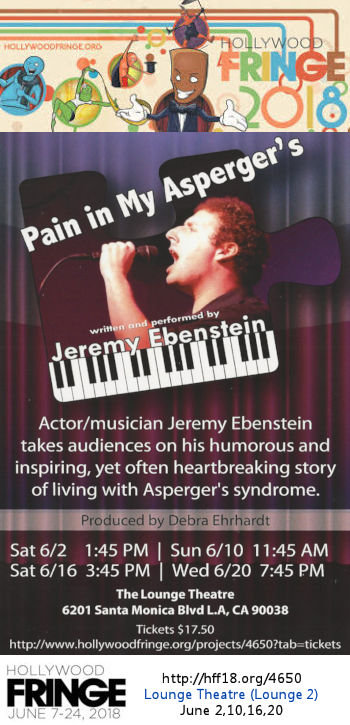 A staple at any Fringe Festival is the one person show. Sometimes they are painful and self indulgent; sometimes they soar to wonderful places — but you can be guaranteed that if you go to a Fringe Festival, you’ll have a fair number from which to choose. HFF18 was no exception. We chose Pain in my Asperger’s based on the subject matter; here’s the description from the Fringe guide:
A staple at any Fringe Festival is the one person show. Sometimes they are painful and self indulgent; sometimes they soar to wonderful places — but you can be guaranteed that if you go to a Fringe Festival, you’ll have a fair number from which to choose. HFF18 was no exception. We chose Pain in my Asperger’s based on the subject matter; here’s the description from the Fringe guide:
Actor/musician, Jeremy Ebenstein, through story and song, takes audiences through his humorous, inspiring, yet often heartbreaking story of living a life with Asperger’s Syndrome. With eight original songs and compositions, Ebenstein chronicles his journey from childhood to adulthood, addressing universal issues like childhood bullying, hopeful romance, and overcoming depression, to his unique take on the struggles of everyday life, from relationships, to being able to hold down the simplest of jobs, yet always striving towards his dreams of being accepted and living a successful life. It’s a story of hope and love, not only for those suffering with Asperger’s Syndrome, who need to overcome the additional challenges that Asperger’s presents, but for all who have ever hoped and dreamed about making something of themselves.
Given that we work with engineers every day, are engineers ourselves, and know numerous folks on the spectrum, this show seemed to hit home. So we decided to see it.
In general, Jeremy Ebenstein (FB) does a good job. His story is moving, and it takes a lot of courage — especially for an Aspie — to get up on stage and tell it. It could use with a bit of editing — at times, it seemed to drag and one had to fight the urge to look at the cell phone for the time. But I view that as a side effect of the Aspie desire to tell too much information; I urge the directing and advising team to see if perhaps ten minutes might be cut — some repetitive examples, perhaps some of the approaches.
However, overall, the ultimate story told by Ebenstein was good. It captured well the difficulties for someone on the spectrum to achieve in the dramatic field. The stories of him in school, and his attempts at forming relationships, were quite good. Luckily, Ebenstein found his music — music is a wonderful too to help people get through so much. His rendition of “Over The Rainbow” during the show was astounding; his other songs were good, although a bit less memorable.
The script for the show was developed by Ebenstein with Jack Fry (FB) in the Jack Fry Solo Workshops. Direction was by Jack Fry (FB) . I’ll note that we’ve seen Fry on stage before, at HFF16, as EInstein. Debra Ehrhardt (FB) served as producer and creative consultant.
There is one more performance of Pain in my Asperger’s : 6/20 at 7:45PM.
 After the show, we had one more stop to make: we had to see the Donald Trump Presidential Library. To be more specific, it was the pop-up installation of The Daily Show Presents: The Donald J. Trump Presidential Twitter Library in West Hollywood (it was there last weekend and this weekend; today is the last day). This museum is dedicated to preserving Donald Trump’s favorite medium of communication: the tweet. The website has a virtual tour, but there are areas devoted to all aspects of his tweets: the people he mentions and disparages, his history of tweeting, the story of how he has used his tweets for good or bad; how he has tweeted about foreign countries, and so forth.
After the show, we had one more stop to make: we had to see the Donald Trump Presidential Library. To be more specific, it was the pop-up installation of The Daily Show Presents: The Donald J. Trump Presidential Twitter Library in West Hollywood (it was there last weekend and this weekend; today is the last day). This museum is dedicated to preserving Donald Trump’s favorite medium of communication: the tweet. The website has a virtual tour, but there are areas devoted to all aspects of his tweets: the people he mentions and disparages, his history of tweeting, the story of how he has used his tweets for good or bad; how he has tweeted about foreign countries, and so forth.
In some ways, this is serious. All Presidential Communications are part of the national archives, and his tweets are being saved in the National Archives. So this is probably the first … perhaps scholarly is too strong … study of these Presidential records. They paint a picture of a man with too much time on his hands … a man who spends too much time on a gold-plated throne … a man who watches far too much “Fox and Friends” … a man who prefers to take his constantly changing and contradictory messages directly to the medium in pre-packaged mouth-sized soundbites.
That give you indigestion.
Seriously, the exhibit was a hoot. It really shows who the man is, which is the point of these archives. Expect future archives of the ripped-up but later reassembled papers received in the Oval Office. Probably with the President’s scribbles annotations on them.
In crayon.
Plus, when you go the library, you get your own “Donald Trump Twitter Name”. I was “Oily Dan”.
The Daily Show Presents: The Donald J. Trump Presidential Twitter Library continues in West Hollywood, at 631 N Robertson, until 10pm today.
***
Ob. Disclaimer: I am not a trained theatre (or music) critic; I am, however, a regular theatre and music audience member. I’ve been attending live theatre and concerts in Los Angeles since 1972; I’ve been writing up my thoughts on theatre (and the shows I see) since 2004. I do not have theatre training (I’m a computer security specialist), but have learned a lot about theatre over my many years of attending theatre and talking to talented professionals. I pay for all my tickets unless otherwise noted. I am not compensated by anyone for doing these writeups in any way, shape, or form. I currently subscribe at 5 Star Theatricals (FB) [the company formerly known as Cabrillo Music Theatre (FB)], the Hollywood Pantages (FB), Actors Co-op (FB), the Chromolume Theatre (FB) ז״ל, a mini-subscription at the Soraya [nee the Valley Performing Arts Center (VPAC)] (FB), and the Ahmanson Theatre (FB). Through my theatre attendance I have made friends with cast, crew, and producers, but I do strive to not let those relationships color my writing (with one exception: when writing up children’s production, I focus on the positive — one gains nothing except bad karma by raking a child over the coals). I believe in telling you about the shows I see to help you form your opinion; it is up to you to determine the weight you give my writeups.
Upcoming Shows:
It’s June — ah, June. That, my friends, means only one thing: the Hollywood Fringe Festival (FB), Here’s our June schedule:
- ✔ Friday, June 1: 8:00pm Family Schmamily (Eclectic Company Theatre (FB)) [which, alas, is closing]
- ✔ Saturday, June 2: 1:30pm 19 Years Later: A Harry Potter Parody (Hobgoblin); 4pm From Toilet to TInseltown(Hobgoblin); 8pm Billy Porter: The Soul of Richard Rodgers at the Soraya [nee the Valley Performing Arts Center (VPAC)].
- ✔ Sunday, June 3: 4:00pm Ingersoll Speaks: Again (Studio C); 6:00pm The Universe (101) (Complex/Dorie).
- ✔ Thursday, June 7: 8:30pm They’ll Be Some Changes Made Today (Hobgoblin)
- ✔ Saturday, June 9: 4:30pm The Story of My Life (Hobgoblin); 8:00pm The Color Purple (Hollywood Pantages (FB))
- ✔ Sunday, June 10: 1:30pm How To Be Lazy and Not Feel Guilty (Complex/OMR); 3:00pm Ageless Wonders: A Grown-Up Kids Guide to Growing Newer (Complex/OMR)
- ✔ Friday, June 15: 6:00pm Shabbabaque at TAS
- ✔ Saturday, June 16: 2:00pm Trojan Woman (Lounge/1); 3:45pm Pain in my Aspergers (Lounge/2)
- Sunday, June 17: 1:00pm Earhart: More Than A F-ing Mystery (McCadden); 2:30pm Attack of the Retro Sci-Fi Futurist (Complex/Ruby); 430p Amanda The Barbarian (Complex/Dorie); 7pm The Bitch is Back: An Elton John Cabaret (Three Clubs)
- Saturday, June 23 (me only): 2:00pm Mime Time (Complex/Ruby); 4pm Cowboy Mouth (Actors Company/Little Theatre); 530pm Monday Morning/Cheese & Things (Actors Company/Little Theatre); 800p Meanwhile, Back at the Super Lair (New American Theatre)
- Sunday, June 24 (me only): 3:00pm A Reasonable Fear of Tubas (Actors Company/Let Live); 4:00pm Beatniks (Actors Company/Let Live); 7:00pm Sweet Charity (Reprise/UCLA (FB))
July will be a tad less busy. It starts with the 50th Anniversary of Gindling Hilltop Camp, followed by On Your Feet at the Hollywood Pantages (FB). For the next weekend, as Jane Eyre The Musical from Chromolume Theatre (FB) looks to be a dead parrot ⚰🐦., we’ve replaced it with Tabletop, a reading of a new musical about tabletop RPGs at the Charles Stewart Howard Playhouse (FB). The third weekend in July brings a Bat Mitzvah in Victorville, and Beauty and The Beast at 5 Star Theatricals (FB) that evening on Saturday, and a hold for the OperaWorks (FB) “Opera ReConstructed” at CSUN on Sunday. The last weekend may be a Muse/ique (FB) show. August starts with Waitress at the Hollywood Pantages (FB) on Saturday, and the Actors Co-Op Too! production of Always Andrews: A Musical Tribute to the Andrews Sisters on Sunday at Actors Co-op (FB). The next weekend brings the last Actors Co-Op Too! production, Twelfth Night, or What You Will at Actors Co-op (FB). There may also be a production of The Most Happy Fella at MTW — I’m not sure about it, but the hold date is on the calendar.
As always, I’m keeping my eyes open for interesting productions mentioned on sites such as Better-Lemons, Musicals in LA, @ This Stage, Footlights, as well as productions I see on Goldstar, LA Stage Tix, Plays411 or that are sent to me by publicists or the venues themselves. Note: Lastly, want to know how to attend lots of live stuff affordably? Take a look at my post on How to attend Live Theatre on a Budget.
 My doctor likes to point out that 50% of all doctors graduated in the bottom half of their class. I mention that because in any competition or comparison (unless those where partial orderings are involved), something is always going to be ranked at the bottom. Even with partial orderings, there is some value that is the lowest value (unless everything is incomparable). That is certainly true for a Fringe Festival: some shows work, some don’t. Some audiences love some shows, some don’t. Even the best show will have audience members for whom it lands with a thud, despite your best efforts. If you care about their opinion at all, you learn what you can from it and improve your show.
My doctor likes to point out that 50% of all doctors graduated in the bottom half of their class. I mention that because in any competition or comparison (unless those where partial orderings are involved), something is always going to be ranked at the bottom. Even with partial orderings, there is some value that is the lowest value (unless everything is incomparable). That is certainly true for a Fringe Festival: some shows work, some don’t. Some audiences love some shows, some don’t. Even the best show will have audience members for whom it lands with a thud, despite your best efforts. If you care about their opinion at all, you learn what you can from it and improve your show.



 After the show, we had one more stop to make: we had to see the Donald Trump Presidential Library. To be more specific, it was the pop-up installation of
After the show, we had one more stop to make: we had to see the Donald Trump Presidential Library. To be more specific, it was the pop-up installation of 
 Recently, after one of the numerous Fringe shows we’ve seen, I was talking to my wife. I opined that if I ever put on a Fringe show, it would likely me getting up and doing a short tutorial on the NIST Risk Management Framework using Powerpoint slides, and it would probably land with a thud. My wife, however, thought that with the right director, it could work…
Recently, after one of the numerous Fringe shows we’ve seen, I was talking to my wife. I opined that if I ever put on a Fringe show, it would likely me getting up and doing a short tutorial on the NIST Risk Management Framework using Powerpoint slides, and it would probably land with a thud. My wife, however, thought that with the right director, it could work…
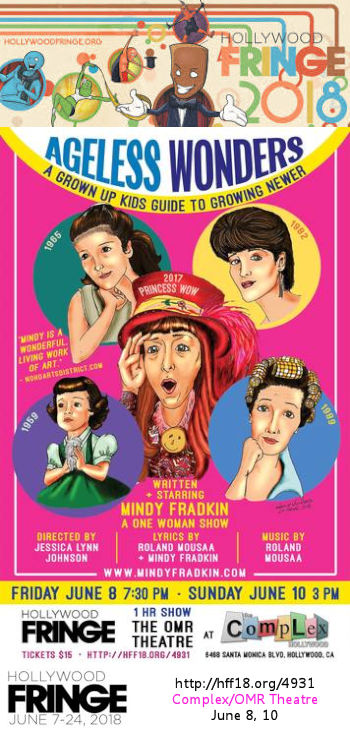

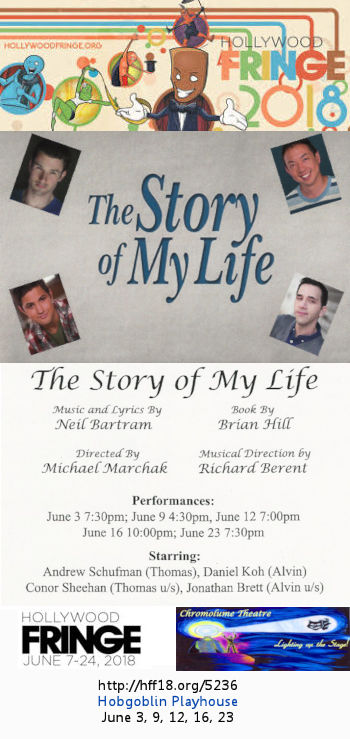

 I’ve been a long-time admirer of
I’ve been a long-time admirer of 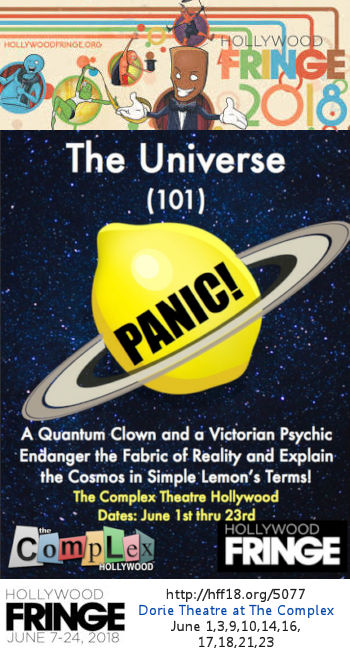 Our second Fringe show,
Our second Fringe show, 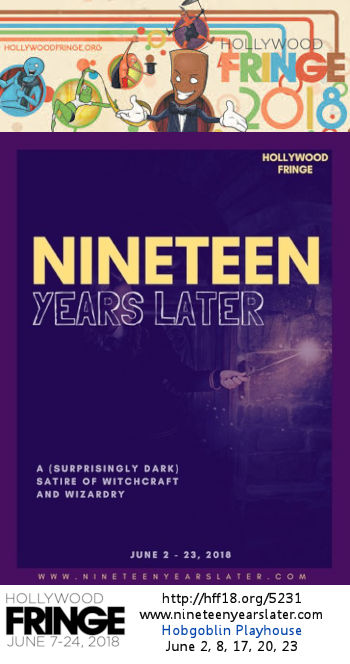

 Our last show of the evening was not a Fringe show. Back in March we were supposed to see Billy Porter: The Soul of Richard Rodgers at
Our last show of the evening was not a Fringe show. Back in March we were supposed to see Billy Porter: The Soul of Richard Rodgers at